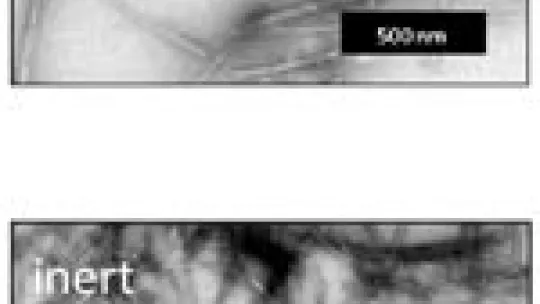Images
A study performed by Xavier Salvatella’s lab indicates that the toxicity of amyloid aggregates depends on their structural properties.
Major neurodegenerative diseases, such as Parkinson’s and Alzheimer’s, are related to the development of protein aggregates in the form of amyloid fibers. Despite the relevance of these deposits, little is known about why they are toxic and the mechanisms by which they damage cells. A study recently published in the Journal of Molecular Biology by researchers at the Institute for Research in Biomedicine (IRB Barcelona) and the University of Cambridge, headed by Xavier Salvatella and Christopher Dobson, sheds some light on the origin of the toxic properties of these aggregates.
Maria Mossuto, a researcher in Salvatella’s lab, has studied the fibers formed by a protein called lysozyme, which are responsible for non-neuropathic systemic amyloidosis, a rare disease. She has observed that this protein can form at least two different fiber types. By changing the fiber formation conditions, she obtained some fibers that were highly stable and structured and others that were less stable and were partly structured and partly disordered. By applying these fibers to cell cultures, the researchers found that the structured fibers had no toxic effect on the cells while the damage produced by the partly disordered ones led to their death. On the basis of these results, the study proposes that toxicity does not depend on the size of the aggregates but on their structural properties.
In spite of this finding there are still many unanswered questions and the future work of the IRB Barcelona lab will focus on studying how these fibers exert their toxic function. For this purpose, the scientists will address whether the aggregates enter cells, whether less ordered fibers break into pieces and then act like oligomers – which could be the reason of their toxicity -, whether there are associations with other proteins that influence the activity of the aggregates, etc. They also want to study whether the fraction of protein that is apparently disordered in the fibers is truly disordered or whether it is partially folded. “Lysozyme is a protein whose function and structure is well known and working with it allows us to understand the fundamental principles underlying the aggregation process. The aim is to establish a methodology that will enable us to study other proteins of special clinical relevance”, says Salvatella.
Reference article:
The Non-Core Regions of Human Lysozyme Amyloid Fibrils Influence Cytotoxicity.
Mossuto MF, Dhulesia A, Devlin G, Frare E, Kumita JR, de Laureto PP, Dumoulin M, Fontana A, Dobson CM, Salvatella X.
Journal of Molecular Biology (2010) doi:10.1016/j.jmb.2010.07.005
Nahia Barbería
About IRB Barcelona
The Institute for Research in Biomedicine (IRB Barcelona) pursues a society free of disease. To this end, it conducts multidisciplinary research of excellence to cure cancer and other diseases linked to ageing. It establishes technology transfer agreements with the pharmaceutical industry and major hospitals to bring research results closer to society, and organises a range of science outreach activities to engage the public in an open dialogue. IRB Barcelona is an international centre that hosts 400 researchers and more than 30 nationalities. Recognised as a Severo Ochoa Centre of Excellence since 2011, IRB Barcelona is a CERCA centre and member of the Barcelona Institute of Science and Technology (BIST).





